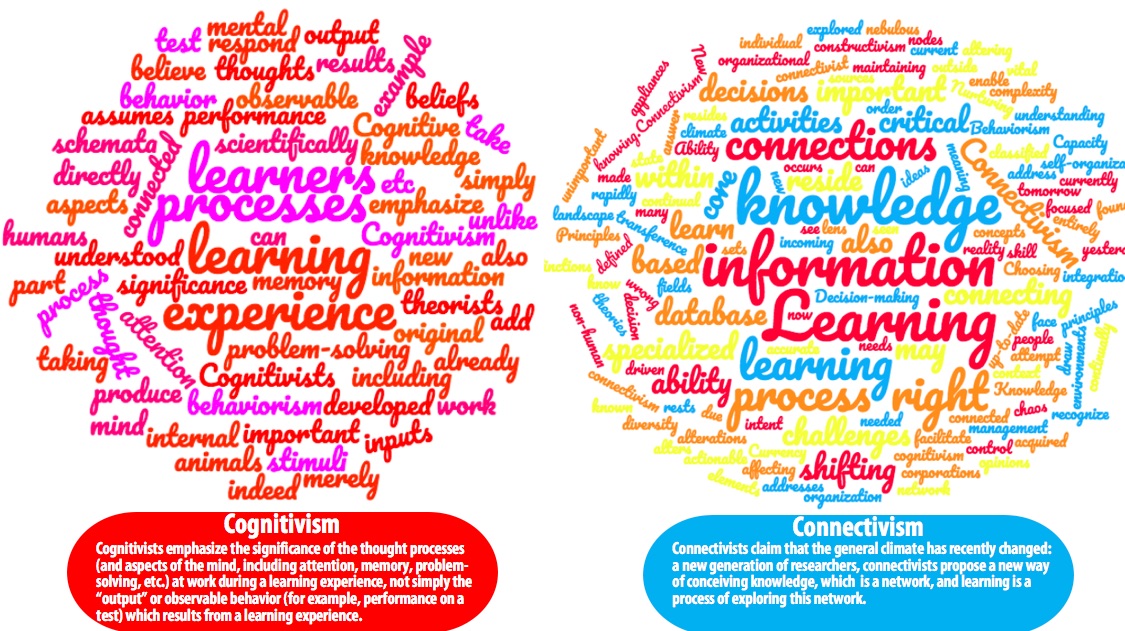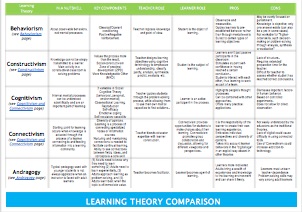
Samples + Deliverables
LDT 200x: Instructional Design Models
LDT 300x: Instructional Design: Digital Media, New Tools and Technology Graphic-design Samples Video Sample Screencast Sample Audio Sample Interactive Module Course Authoring in Sutori
LDT 400x: Instructional Design Course Evaluation & Capstone Project Full, 3-Week Course Design/ Articulate RISE
Comparing Learning Theories
LDT100x Instructional Design and Technology: Learning Theories
The purpose of this project was to compare several major
learning theories in terms of KEY COMPONENTS, TEACHER ROLE,
LEARNER ROLE, PROS, and CONS
Download Table
See References for Table
Applications of and Reflections on Learning Theories:
Behaviorism
This project asked learners to provide a description of a learning scenario in which behaviorism is the primary learning theory that drives the activity.
A Behaviorist Approach to Eliminating Filler Words among Public Speakers
In the learning environment in which this scenario is situated, behaviorist methods have already been applied with varying degrees of success. The most widely used method is to appoint a role-player each time speeches are presented whose job is to track and publicly report the filler words for each speaker. This method provides low-level rewards ("you had very few filler words today") and punishments ("you had quite a number of filler words today"). This method raises awareness of behavior but does not go very far in changing it.
Another method is for the role-player to ring a bell or sound a buzzer every time a speaker utters a filler word. This method does a bit more to change behavior because the speaker is embarrassed that his or her filler words cause disruption. This disruption is a major downside of this approach as it impairs the flow of each speech and the event in general.
A third method is to collect a "micro-fine," such as (in the US) a nickel, dime, or quarter for each filler word uttered. The proceeds are pooled and used toward a fun activity for the group. This method can also contribute to filler-word reduction, but the downside is that many people no longer carry coins.
While the first method provides low-key rewards, the the other two rely on punishment to eradicate the negative behavior. I am proposing a behaviorist method that is reward-focused rather than punishment-focused.
This is a hybrid learning environment in which speeches can be given face to face or online. Learners, however, supplement and track their learning online.
For this new method, a phone app would be developed that would interface with each learner's online learning space. Keramida (2015, para. 13) notes, "An instructional design for eLearning based on a behavioristic approach sets the type of reactions to be received by learners, after interacting with the online training material." Thus, each learner's learning space must provide content on filler word and tips for avoiding them in speech. Using the app during a speaking event, the filler-word role-player would track each learner's speeches for filler words, with the total number posting in the learner's learning space. A reward system is created in which the learner earns a significant badge for eliminating (or nearly) filler words, with possible interim awards for reduction in filler-word use. Those who achieve the top filler-word-elimination badge could optionally be publicly recognized by all learners in the learning environment.
This method avoids embarrassing and punishing learners and does not depend on people carrying coins. It fits with current practices of motivating and rewarding adult learners with badges (Finkelstein, Knight, Manning, 2013, July 16); Cole, Gray, & Martin, n.d; Bowen, 2013; Ady, Kinsella, and Paynter, 2015; Rayhill, n.d.). "Digital badges," writes Rahill (n.d.) "are compelling because they offer a meaningful way to visually recognize learning through a narrative."
Keramida (2013, para. 6) asserts that "objectivism is the key to remember ... to decide whether a behavioristic approach is appropriate for your eLearning activities or not." Rather than ask if a single correct answer exists in this filler-word scenario, we can ask, "does a single correct behavior exist?" Arguably, yes. Keramida notes that objective facts don't change. It's difficult to imagine a scenario in which the undesirability of filler words in speeches would ever change.
Behaviorism pros and cons:
Pros:
Behaviorism is observable and measurable. Behaviorism guides learners to pre-established behavior rather than through mental events (Keramida, 2015, para. 4) Behaviorism is suited to certain types of learning objectives
Cons:
Behaviorism may be overly focused on punishment. In Behaviorism, knowledge is objective; only one answer exists (can also be a pro in some cases). Behaviorism is not workable for "higher-order skills, such decision-making or problem-solving through analysis, synthesis or evaluation" (Keramida, 2015, para. 5).
References
Ady, K.; Kinsella, K.; and Paynter, A. (2015). Digital Distinction. Retrieved from https://learningforward.org/journal/august-2015-issue/digital-distinction/
Bowen, K. (2013, Oct. 17). Five Ways Digital Badges Can Influence Learning. Retrieved from https://evolllution.com/opinions/ways-digital-badges-influence-learning/
Cole, K.; Gray, M.; & Martin, N. (n.d). Motivating Adult Learners with Digital Badges. Retrieved from https://badges.atavist.com/digital-badges
Finkelstein, J.; Knight, E.; & Manning, S. (2013, July 16). The Potential and Value of Using Digital Badges for Adult Learners. Retrieved from https://lincs.ed.gov/publications/pdf/AIR_Digital_Badge_Report_508.pdf
Keramida, M. (2015, May 28). Behaviorism In Instructional Design For eLearning: When And How To Use. Retrieved from https://elearningindustry.com/behaviorism-in-instructional-design-for-elearning-when-and-how-to-use
Rayhill, B. (n.d.). Digital Badges: Recognizing and Rewarding Education. Retrieved from https://www.coursestorm.com/blog/digital-badges-recognizing-rewarding-education/
Constructivism
For this project, learners gained practice in creating an infographic to present an overview of Constructivism and describe a learning scenario that presents the learning theory in practice.
 Full
References
Full
References - Constructivism and Social Constructivism in the Classroom. (n.d.). Retrieved from http://www.ucdoer.ie/index.php/Education_Theory/Constructivism_and_Social_Constructivism_in_the_Classroom
- McLeod, S. (2019). What Is the Zone of Proximal Development? Retrieved from https://www.simplypsychology.org/Zone-of-Proximal-Development.html
- Tchoshanov, M. (2013). Engineering of Learning:Conceptualizing e-Didactics. Retrieved from https://iite.unesco.org/pics/publications/en/files/3214730.pdf
Cognitivism + Connectivism
For this project, learners presented an overview and comparison of both Cognitivism and Connectivism in a text-based or a visual way (I chose visual) and described a learning scenario that presents each learning theory in practice. I used the same learning scenario for each theory and then altered the scenario to fit the learning-theory constructs.

Andragogy
For this project, learners again gained practice
in creating an infographic, this one about
Andragogy, including an overview of the theory, the
five assumptions, key aspects for design and an
example of a learning scenario applying those
concepts.
For this project, learners again gained practice in creating an infographic, this one about Andragogy, including an overview of the theory, the five assumptions, key aspects for design and an example of a learning scenario applying those concepts.





